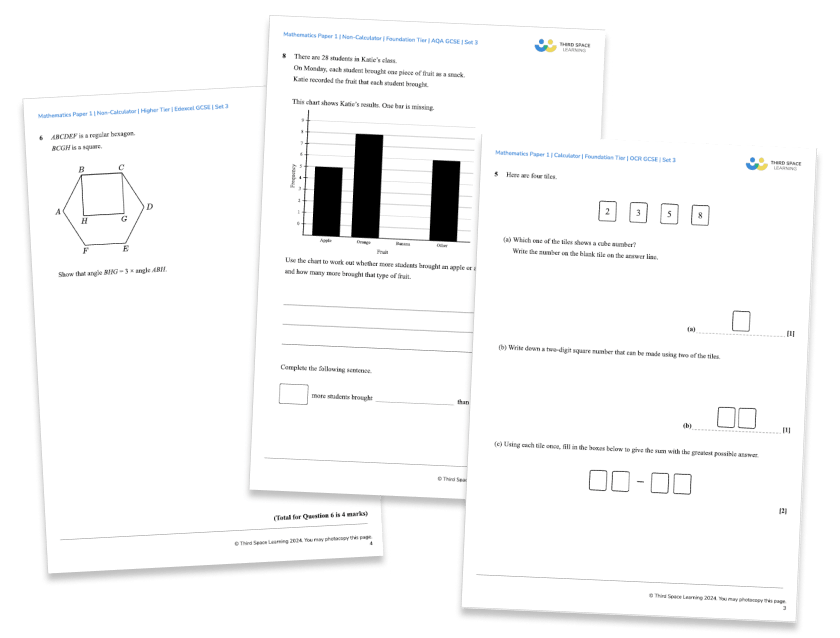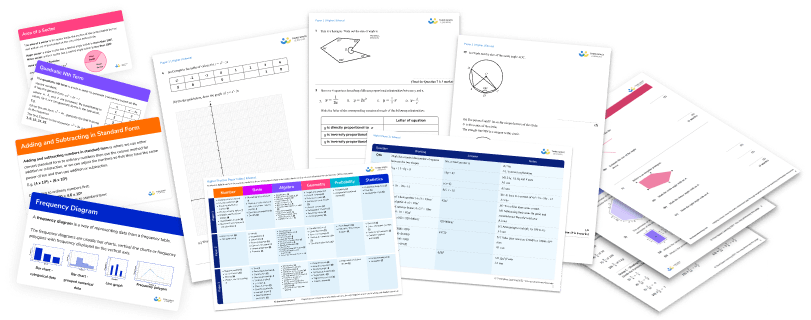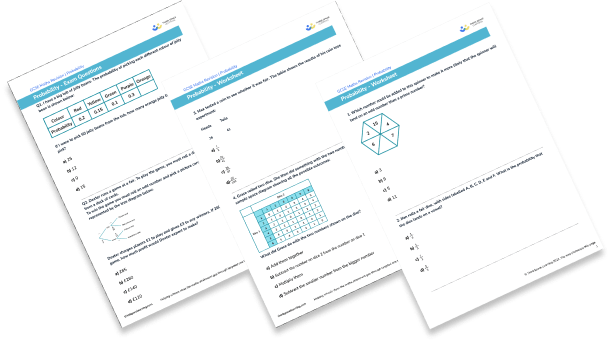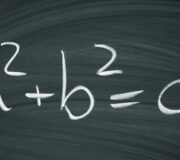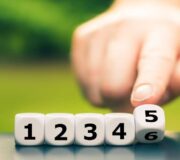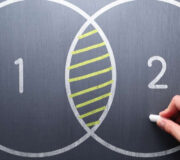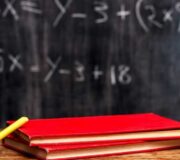15 Probability Questions And Practice Problems (KS3 & KS4): Harder GCSE Exam Style Questions Included
Probability questions and probability problems require students to work out how likely it is that something is to happen. Probabilities can be described using words or numbers. Probabilities range from 0 to 1 and can be written as fractions, decimals or percentages.
Here you’ll find a selection of probability questions of varying difficulty showing the variety you are likely to encounter in KS3 and KS4 including several GCSE exam-style questions.
GCSE MATHS 2026: STAY UP TO DATE
Join our email list to stay up to date with the latest news, revision lists and resources for GCSE maths 2026. We’re analysing each paper during the course of the 2026 GCSEs in order to identify the key topic areas to focus on for your revision.
GCSE dates 2026
GCSE results (2026 when available)
Get ahead on revision with the GCSE maths papers analysis from 2025:
Analysis of GCSE Maths Paper 1 2025
Analysis of GCSE Maths Paper 2 2025
GCSE Maths Paper Analysis and Summary 2025
GCSE Maths Teacher Survey Results 2025
What are some real life examples of probability?
The more likely something is to happen, the higher its probability. We think about probabilities all the time. For example, you may have seen that there is a 20% chance of rain on a certain day or thought about how likely you are to roll a 6 when playing a game, or to win in a raffle when you buy a ticket.
How to calculate probabilities
The probability of something happening is given by:
We can also use the following formulae to help us calculate probabilities and solve problems:
- Probability of something not occuring = 1 – probability of if occurring
P(not\;A) = 1 - P(A) - For mutually exclusive events:
Probability of event A OR event B occurring = Probability of event A +
Probability of event B
P(A\;or\;B) = P(A)+P(B) - For independent events:
Probability of event A AND event B occurring = Probability of event A times probability of event B
P(A\;and\;B) = P(A) × P(B)
Download this 15 Probability Questions And Practice Problems (KS3 & KS4) Worksheet
Help your students prepare for their Maths GSCE with this free Probability worksheet of 15 multiple choice questions and answers.
Download Free Now!KS3 probability questions
In KS3 probability questions introduce the idea of the probability scale and the fact that probabilities sum to one. We look at theoretical and experimental probability as well as learning about sample space diagrams and venn diagrams.
Year 7 probability questions
1. Which number could be added to this spinner to make it more likely that the spinner will land on an odd number than a prime number?




Currently there are two odd numbers and two prime numbers so the chances of landing on an odd number or a prime number are the same. By adding 3, 5 or 11 you would be adding one prime number and one odd number so the chances would remain equal.
By adding 9 you would be adding an odd number but not a prime number. There would be three odd numbers and two prime numbers so the spinner would be more likely to land on an odd number than a prime number.
2. Ifan rolls a fair dice, with sides labelled A, B, C, D, E and F. What is the probability that the dice lands on a vowel?




A and E are vowels so there are 2 outcomes that are vowels out of 6 outcomes altogether.
Therefore the probability is \frac{2}{6} which can be simplified to \frac{1}{3} .
Year 8 probability questions
3. Max tested a coin to see whether it was fair. The table shows the results of his coin toss experiment:
Heads Tails
26 41
What is the relative frequency of the coin landing on heads?




Max tossed the coin 67 times and it landed on heads 26 times.
\text{Relative frequency (experimental probability) } = \frac{\text{number of successful trials}}{\text{total number of trials}} = \frac{26}{67}
4. Grace rolled two dice. She then did something with the two numbers shown. Here is a sample space diagram showing all the possible outcomes:
What did Grace do with the two numbers shown on the dice?
Add them together

Subtract the number on dice 2 from the number on dice 1

Multiply them

Subtract the smaller number from the bigger number

For each pair of numbers, Grace subtracted the smaller number from the bigger number.
For example, if she rolled a 2 and a 5, she did 5 − 2 = 3.
Year 9 probability questions
5. Alice has some red balls and some blue balls in a bag. Altogether she has 25 balls. Alice picks one ball from the bag. The probability that Alice picks a red ball is x and the probability that Alice picks a blue ball is 4x. Work out how many blue balls are in the bag.




Since the probability of mutually exclusive events add to 1:
\begin{aligned}
x+4x&=1\\\\
5x&=1\\\\
x&=\frac{1}{5}
\end{aligned}
\frac{1}{5} of the balls are red and \frac{4}{5} of the balls are blue.
\frac{4}{5} \text{ of } 25 = 20
6. Arthur asked the students in his class whether they like maths and whether they like science. He recorded his results in the venn diagram below.
How many students don’t like science?




We need to look at the numbers that are not in the ‘Like science’ circle. In this case it is 9 + 7 = 16.
KS4 probability questions
In KS4 probability questions involve more problem solving to make predictions about the probability of an event. We also learn about probability tree diagrams, which can be used to represent multiple events, and conditional probability.
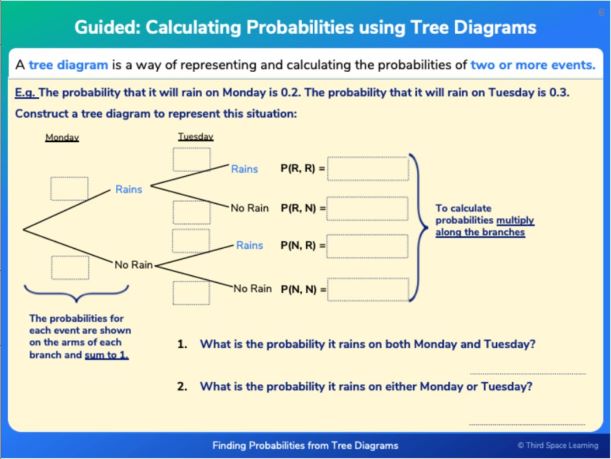
Year 10 probability questions
7. A restaurant offers the following options:
Starter – soup or salad
Main – chicken, fish or vegetarian
Dessert – ice cream or cake
How many possible different combinations of starter, main and dessert are there?




The number of different combinations is 2 × 3 × 2 = 12.
8. There are 18 girls and 12 boys in a class. \frac{2}{9} of the girls and \frac{1}{4} of the boys walk to school. One of the students who walks to school is chosen at random. Find the probability that the student is a boy.




First we need to work out how many students walk to school:
\frac{2}{9} \text{ of } 18 = 4
\frac{1}{4} \text{ of } 12 = 3
4 + 3 = 7
7 students walk to school. 4 are girls and 3 are boys. So the probability the student is a boy is \frac{3}{7} .
9. Rachel flips a biased coin. The probability that she gets two heads is 0.16. What is the probability that she gets two tails?




We have been given the probability of getting two heads. We need to calculate the probability of getting a head on each flip.
Let’s call the probability of getting a head p.
The probability p, of getting a head AND getting another head is 0.16.
Therefore to find p:
\begin{aligned} p × p = 0.16\\\\ p^2 = 0.16\\\\ p = 0.4. \end{aligned}
The probability of getting a head is 0.4 so the probability of getting a tail is 0.6.
The probability of getting two tails is 0.6 × 0.6 = 0.36.
GCSE foundation probability questions
10. I have a big tub of jelly beans. The probability of picking each different colour of jelly bean is shown below:
If I were to pick 60 jelly beans from the tub, how many orange jelly beans would I expect to pick?




First we need to calculate the probability of picking an orange. Probabilities sum to 1 so 1 − (0.2 + 0.15 + 0.1 + 0.3) = 0.25.
The probability of picking an orange is 0.25.
The number of times I would expect to pick an orange jelly bean is 0.25 × 60 = 15.
11. Dexter runs a game at a fair. To play the game, you must roll a dice and pick a card from a deck of cards.
To win the game you must roll an odd number and pick a picture card. The game can be represented by the tree diagram below.
Dexter charges players £1 to play and gives £3 to any winners. If 260 people play the game, how much profit would Dexter expect to make?




Completing the tree diagram:
Probability of winning is \frac{1}{2} \times \frac{4}{13} = \frac{4}{26}
If 260 play the game, Dexter would receive £260.
The expected number of winners would be \frac{4}{26} \times 260 = 40
Dexter would need to give away 40 × £3 = £120.
Therefore Dexter’s profit would be £260 − £120 = £140.
12. A coin is tossed three times. Work out the probability of getting two heads and one tail.




There are three ways of getting two heads and one tail: HHT, HTH or THH.
The probability of each is \frac{1}{2} \times \frac{1}{2} \times \frac{1}{2} = \frac{1}{8}
Therefore the total probability is \frac{1}{8} +\frac{1}{8} + \frac{1}{8} = \frac{3}{8}
GCSE higher probability questions
13. 200 people were asked about which athletics event they thought was the most exciting to watch. The results are shown in the table below.
A person is chosen at random. Given that that person chose 100m, what is the probability that the person was female?




Since we know that the person chose 100m, we need to include the people in that column only.
In total 88 people chose 100m so the probability the person was female is \frac{32}{88} .
14. Sam asked 50 people whether they like vegetable pizza or pepperoni pizza.
37 people like vegetable pizza.
25 people like both.
3 people like neither.
Sam picked one of the 50 people at random. Given that the person he chose likes pepperoni pizza, find the probability that they don’t like vegetable pizza.




We need to draw a venn diagram to work this out.
We start by putting the 25 who like both in the middle section. The 37 people who like vegetable pizza includes the 25 who like both, so 12 more people must like vegetable pizza. 3 don’t like either. We have 50 – 12 – 25 – 3 = 10 people left so this is the number that must like only pepperoni.
There are 35 people altogether who like pepperoni pizza. Of these, 10 do not like vegetable pizza. The probability is \frac{10}{35} .
15. There are 12 marbles in a bag. There are n red marbles and the rest are blue marbles. Nico takes 2 marbles from the bag. Write an expression involving n for the probability that Nico takes one red marble and one blue marble.




We need to think about this using a tree diagram. If there are 12 marbles altogether and n are red then 12-n are blue.
To get one red and one blue, Nico could choose red then blue or blue then red so the probability is:
\begin{aligned} \frac{n}{12} \times \frac{12-n}{11} + \frac{12-n}{11} \times \frac{n}{11} &= \frac{n(12-n)}{132} + \frac{n(12-n)}{132}\\\\ &= \frac{2n(12-n)}{132}\\\\ &=\frac{n(12-n)}{66} \end{aligned}
More KS3 and KS4 maths questions?
Try these:
- 25 GCSE maths questions
- 15 Ratio questions
- 15 Algebra questions
- 15 Trigonometry questions
- 15 Simultaneous equation questions
- 15 Venn diagram questions
- 15 Pythagoras theorem questions
- Long division questions
DO YOU HAVE STUDENTS WHO NEED MORE SUPPORT IN MATHS?
Skye – our AI maths tutor built by teachers – gives students personalised one-to-one lessons that address learning gaps and build confidence.
Since 2013 we’ve taught over 2 million hours of maths lessons to more than 170,000 students to help them become fluent, able mathematicians.
Explore our AI maths tutoring or find out how a GCSE maths tutor could support students in your school.
